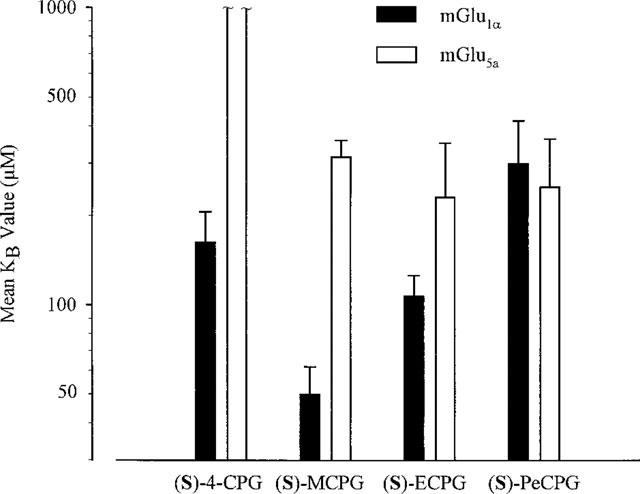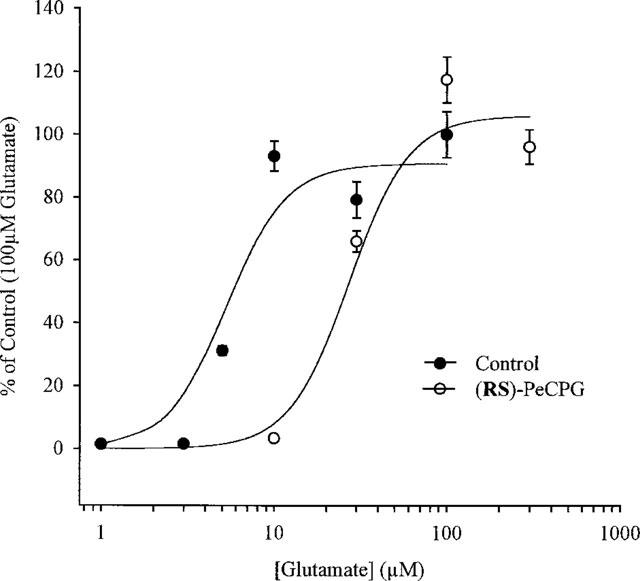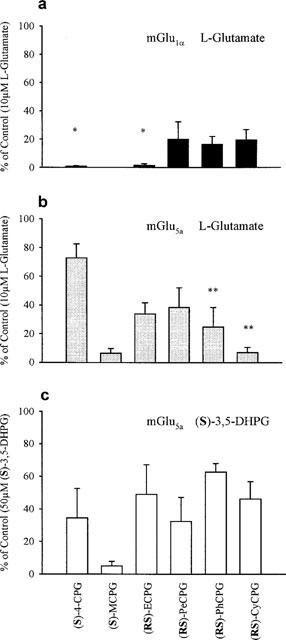This product is for research use only, not for human use. We do not sell to patients.

| Size | Price | Stock |
|---|---|---|
| 2mg | $140 | 3-6 Days |
| 5mg | $220 | 3-6 Days |
| 10mg | $350 | 3-6 Days |
| 25mg | $550 | 3-6 Days |
| 50mg | $950 | 3-6 Days |
| 100mg | $1650 | 3-6 Days |
Cat #: V3333 CAS #: 134052-73-6 Purity ≥ 98%
Description: (S)-4CPG [also known as (S)-4-Carboxyphenylglycine, and (S)-4C-PG] is a novel, potent, competitive and orally bioactive antagonist of metabotropic glutamate receptor 1 (mGluR) with selectivity for mGluR-1 over mGluR-5. Group I (mGluR-1 and mGluR-5) receptors are coupled to Gq/11 and are activators of phospholipase C. (S)-4-CPG and (S)-MCPG were the most selective mGlu1alpha receptor antagonists. Longer chain alpha-carbon substitutions resulted in a progressive loss of antagonist affinity at mGlu1alpha receptors but not at mGlu5a receptors. Thus mGlu1alpha receptor antagonists require small aliphatic groups at the alpha-position. Alpha-cyclopropyl-4-CPG showed a tendency towards mGlu5a selectivity, suggesting that bulky groups at this position may favour mGlu5a receptor antagonism.
Publications Citing InvivoChem Products
Product Promise

- Physicochemical and Storage Information
- Protocol
- Related Biological Data
- Stock Solution Preparation
- Quality Control Documentation
| Molecular Weight (MW) | 195.17 |
|---|---|
| Molecular Formula | C9H9NO4 |
| CAS No. | 134052-73-6 |
| Storage | -20℃ for 3 years in powder form |
| -80℃ for 2 years in solvent | |
| Solubility In Vitro | DMSO: 10 mM |
| Water: N/A | |
| Ethanol: N/A | |
| SMILES Code | O=C(O)[C@@H](N)C1=CC=C(C(O)=O)C=C1 |
| Synonyms | (S)-4CPG; (S)-4C-PG; (S)-4-Carboxyphenylglycine |
| Solvent volume to be added | Mass (the weight of a compound) | |||
|---|---|---|---|---|
| Mother liquor concentration | 1mg | 5mg | 10mg | 20mg |
| 1mM | 5.1237 mL | 25.6187 mL | 51.2374 mL | 102.4748 mL |
| 5mM | 1.0247 mL | 5.1237 mL | 10.2475 mL | 20.4950 mL |
| 10mM | 0.5124 mL | 2.5619 mL | 5.1237 mL | 10.2475 mL |
| 20mM | 0.2562 mL | 1.2809 mL | 2.5619 mL | 5.1237 mL |
This equation is commonly abbreviated as: C1 V1 = C2 V2
- (1) Please be sure that the solution is clear before the addition of next solvent. Dissolution methods like vortex, ultrasound or warming and heat may be used to aid dissolving.
- (2) Be sure to add the solvent(s) in order.







































